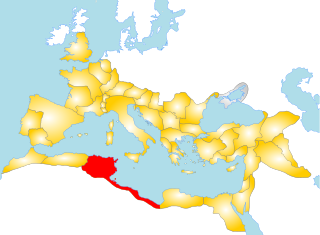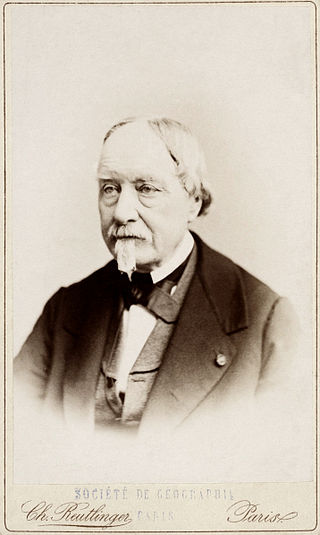
Much of the history of Algeria has taken place on the fertile coastal plain of North Africa, which is often called the Maghreb. North Africa served as a transit region for people moving towards Europe or the Middle East, thus, the region's inhabitants have been influenced by populations from other areas, including the Carthaginians, Romans, and Vandals. The region was conquered by the Muslims in the early 8th century AD, but broke off from the Umayyad Caliphate after the Berber Revolt of 740. During the Ottoman period, Algeria became an important state in the Mediterranean sea which led to many naval conflicts. The last significant events in the country's recent history have been the Algerian War and Algerian Civil War.

Ifriqiya, also known as al-Maghrib al-Adna, was a medieval historical region comprising today's Tunisia, eastern Algeria, and Tripolitania. It included all of what had previously been the Byzantine province of Africa Proconsularis and extended beyond it, but did not include the Mauretanias.

The Hammadid dynasty, also known as the Hammadid Emirate or the Kingdom of Bejaia, was a medieval Islamic kingdom located in the central Maghreb, encompassing present-day Algeria. It was established at the beginning of the 11th century when Hammad ibn Buluggin declared himself emir, thus splitting the Zirid domains into two separate dynasties. Under the reign of Emir Al Nasir, the emirate briefly became the most important state in the Maghreb, and reached its greatest territorial extent, stretching from Tlemcen in the west to Tunis in the east, and from the Mediterranean Sea in the north to the desert oasis of Ouargla and Oued Righ in the south. While they briefly controlled the principality of Fez in the west and cities like Sfax, Kairouan, Laribus, and Tripoli to the east.

The Zayyanid dynasty or Abd al-Wadids was a Berber Zenata dynasty that ruled the Kingdom of Tlemcen, mainly in modern Algeria centered on the town of Tlemcen in northwest Algeria. The Zayyanid dynasty's rule lasted from 1235 to 1557.

Buluggin ibn Ziri, often transliterated Bologhine, in full ʾAbū al Futūḥ Sayf ad Dawlah Bulukīn ibn Zīrī ibn Manād aṣ Ṣanhājī was the first leader of the Sanhaja Berber dynasty of Zirids to serve as viceroy of Ifriqiya under the Fatimid Caliphs, founding a dynasty that continued to rule the region after him.
The Maghrawa or Meghrawa were a large Berber tribal confederation in North Africa. They were the largest branch of the Zenata confederation. Their traditional territories around the time of Muslim expansion into the Maghreb in the 7th century were around present-day northeastern Algeria. They ruled parts of the western Maghreb on behalf of the Umayyad Caliphate of Cordoba at the end of the 10th century and during the first half of the 11th century.

William McGuckin, known as Baron de Slane was an Irish orientalist. He became a French national on 31 December 1838. and held the post of the Principal Interpreter of Arabic of the French Army from 1 September 1846 until his retirement on 28 March 1872. He is known for publishing and translating a number of important medieval Arabic texts.
The Banu Ifran or Ifranids, were a Zenata Berber tribe prominent in the history of pre-Islamic and early Islamic North Africa. In the 8th century, they established a kingdom in the central Maghreb, with Tlemcen as its capital.
Ziri ibn Atiyya was the tribal leader of the Berber Maghrawa tribal confederacy and kingdom in Fez.
Abd al-Aziz ibn Mansur was the ruler of the Hammadids from 1104 to 1121.
Abu Yedda, also known as Ibn Yedda Douanas or Yedder, was a Berber leader of the 10th century. He was a member of the tribe of Banu IfranWhen he murdered his uncle Habbous, the Banu Ifren tribe was unhappy with him. Yedda crossed into Spain with Zenetes troops in 992. Yedda partnered with the Berbers when they defeated the armies of the King of Spain and the Mehdi. He was killed and buried in Spain after the battle. His family governed in Cordoba for three centuries.

Honaine is a town and commune in Tlemcen Province in northwestern Algeria.

Igawawen or Gawawa, mostly known as Zwawa were a group of Kabyle tribes inhabiting the Djurdjura mountains, Greater Kabylia, in Algeria. The Zouaoua are a branch of the Kutama tribe of the Baranis Berbers.

The Kingdom of Tlemcen or Zayyanid Kingdom of Tlemcen was a kingdom ruled by the Berber Zayyanid dynasty in what is now the northwest of Algeria. Its territory stretched from Tlemcen to the Chelif bend and Algiers, and at its zenith reached Sijilmasa and the Moulouya River in the west, Tuat to the south and the Soummam in the east.
Abu Said Uthman I, or Othmane ibn Yaghmurasen or in Algerian Arabic, ruled the Zenata Berber Kingdom of Tlemcen from March 1283 to June 1304.
Sulaymān I,, sometimes called Sidi Sliman or Moulay Slimane, was the brother of Idris I of Morocco, son of the great grandson of the caliph Ali and Fatima, daughter of the Islamic prophet Muhammad. He was probably born around 730 and died in 814, perhaps in Ain El Hout in the province of Tlemcen in Algeria.
Abu Kamal Temim bin Ziri bin Ya'la Al-Yafrani, was the leader of the Berber Zenata tribe known as Banu Ifren from 1029 to 1035 during the Middle Ages in the Maghreb. He is the grandson of Yala Ibn Mohammed.
Abu Soda ibn Khalila Al-Ifreni was the Emir of the Zenatas from the Banu Ifran up until his death in 1058 cause of the Banu Hilal.

The Zayyanid-Almohad wars (1236–1248), also known as the Tlemcen-Almohad wars, were a series of conflicts that occurred between the Zayyanid dynasty, rulers of the Kingdom of Tlemcen in present-day Algeria, and the Almohad Caliphate, a North African Berber-Muslim empire that existed from the 12th to the 13th centuries. These wars took place during the Almohad period and were primarily fought over territorial control and influence in the Maghreb region of North Africa.

Following the spread of Islam, Algeria experienced three major waves of Arab migration that significantly altered its demographics and culture. The first wave occurred in the 7th century, with Arab political and trading elites settling mainly in large cities following the Muslim conquest of the Maghreb. This was followed by the large-scale migration of Bedouin tribes, including Banu Hilal, Banu Sulaym, and Banu Ma'qil in the 11th century, who settled in rural areas, especially the plains. Around the same time, Arabs from al-Andalus (Moors) also migrated, further contributing to the Arabization of the country. Gabriel Martinez described these Andalusian Arabs as the "watchdogs" of the Arabic language.










